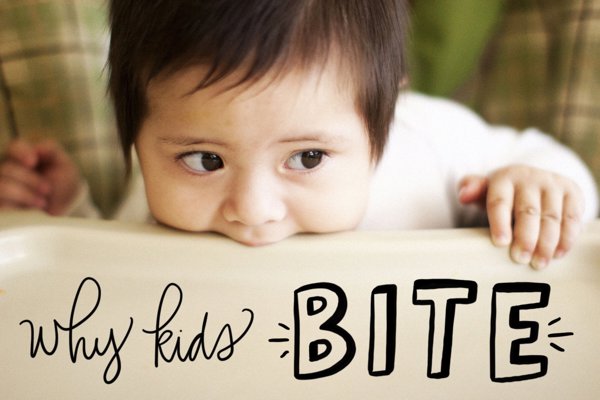Why Kids Bite

Biting is a normal characteristic seen in infants, toddlers, and 2-year olds. As children mature, gain self-control, and develop problem-solving skills, they usually outgrow this behavior. Some children bite instinctively, because they have not developed self-control.
Children bite in order to cope with a challenge or fulfill a need.
For example, your child may be biting to express a strong feeling (like frustration), communicate a need for personal space (maybe another child is standing too close) or to satisfy a need for oral stimulation.
A child might bite to:
- Relieve pain from teething.
- Explore cause and effect (“What happens when I bite?”).
- Experience the sensation of biting.
- Satisfy a need for oral-motor stimulation.
- Imitate other children and adults.
- Feel strong and in control.
- Get attention.
- Act in self-defense.
- Communicate needs and desires, such as hunger or fatigue.
- Communicate or express difficult feelings, such as frustration, anger, confusion, or fear.
To set the stage for effectively and appropriately addressing this challenge, avoid calling or thinking of your child as a “biter” and ask others not to use this term. Labeling children can actually lead to them taking on the identity assigned to them, which can intensify biting behavior rather than eliminating it.
There are many strategies to prevent biting. However, always remember that a new behavior takes time:
1. Distract your child with a toy or book
Suggest looking out the window or take a walk to another room or outside. The goal is to reduce the tension and shift your child’s attention.
2. Suggest how your child might handle the situation that is triggering the need to bite
If you think your child might be biting due to a need for oral stimulation, offer your child something he can safely bite and chew—a cracker, some carrot sticks, or a teether.
3. Suggest ways to share if your child is biting out of anger or frustration of sharing toys
In a group caregiving setting, you will want to make sure that the classroom has more than one of the most popular toys. Sharing is one of the most common triggers for biting.
4. Reading books about biting can also help
As you read, ask your child how the different characters might be feeling. If you have an older toddler, you can ask him to “read” the book to you, by telling you what is happening based on the pictures. Some of our favorite books about biting can be found here.
Additionally, some children bite because they are feeling overwhelmed in certain daily routines or situations.
You can manage these settings by being proactive in the situation:
- Keep televisions, radios or music off or at a very low volume.
- Avoid big crowds and high-activity settings like the mall or the playground on a sunny Saturday morning.
- Schedule activities with a lot of sensory input (like clothes-shopping or trips to dentist or doctor) for your child’s “best” times of day, when he is fed and well-rested.
- Talk with your child’s other caregivers about his difficulty managing a lot of sensory input. Brainstorm ways to reduce the stimulation in his other caregiving settings.
- Give your child a firm “bear” hug when you sense she is feeling stressed and out of control and perhaps about to bite. This can help children feel “held together” which can be very soothing.
- Create a “cozy corner” in your house with pillows, books and other quiet toys like stuffed animals, or use a playtent as a safe place to take a break. Explain that this is a place your child can go if he wants to be alone or feels out of control and needs to cool down. Ensure that your child’s other caregiving settings have a “cozy corner” as well.
Always remember, as a parent or caregiver, to practice patience and offer support to the child going through this difficult stage.